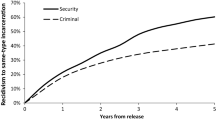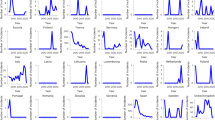Abstract
The potential of terrorists to re-offend after their release from prison is of much concern in many countries around the world. Yet, there is little research on terrorist recidivism, and risk factors that might contribute to it, as data concerning released offenders of terrorism is scarce. In this chapter, we investigate terrorist recidivism using a large dataset of offenders identified as “security offenders”, which are related to terrorism in Israel, in the years 2004–2017. While the overall rate of recidivism of this cohort is lower than the Israeli criminal recidivism rate, some risk factors affect security offenders similarly to other criminals. While some risk factors known to affect criminal recidivism, such as affiliation to criminal organizations and age, show similar patterns for terrorist recidivism, factors such as length of incarceration and type of crime, show different trends. We discuss the role of these factors within the Israeli and global context.
Access this chapter
Tax calculation will be finalised at checkout
Purchases are for personal use only
Similar content being viewed by others
Notes
- 1.
According to information presented in the annual Terrorism Situation and Trend Report (TE-STAT) published by Europol, the average sentence lengths in countries such as the UK, Germany, and France range from 4–9 years depending on the year of the report. Sentences for terrorism offences are notoriously short in fact (Chesney 2007), and can be made shorter based on the offence stemming from a sting operation (Norris 2019), or conviction stemming from plead bargaining (De Kerchove and Höhn 2016).
- 2.
While the Palestinian Authority sometimes denies such claims, the Arabic website for the Commission of Detainees and ex-Detainees Affairs includes links to laws and regulations concerning payments to detainees and former detainees, as well as exclusive job advertisements which include being a former detainee as a pre-requisite for application. See http://cda.gov.ps/
- 3.
Polls conducted by the Palestinian Center for Policy and Survey Research (PCPSR) consistently show that support for violence and armed struggle is consistently greater in “villages/towns/cities” as well as “refugee camps” than it is in “the West Bank”. The results of the polls can be found at http://pcpsr.org/en/node/154.
References
Altier M. B., Horgan, J., Thoroughgood, C. (2012). Returning to the fight: what the literature on criminal recidivism can contribute to our understanding of terrorist recidivism. Department of Homeland Security report
Altier, M. B., Thoroughgood, C. N., & Horgan, J. G. (2014). Turning away from terrorism: Lessons from psychology, sociology, and criminology. Journal of Peace Research, 51(5), 647–661.
Altier, M. B., Leonard Boyle, E., & Horgan, J. G. (2019). Returning to the fight: an empirical analysis of terrorist reengagement and recidivism. Terrorism and Political Violence, 1–25.
Bovenkerk, F. (2011). On leaving criminal organizations. Crime, Law and Social Change, 55(4), 261–276.
Blokland, A. A. J., & Nieuwbeerta, P. (2004). Recidive en het beëindigen van de criminele carrière over een periode van 25 jaar. Tijdschrift voor Criminologie, 46(1), 18–36.
Ben-Zvi, K., & Walk, D. (2011). Recidivism shel asirim plilim m’shuchrarey 2004 b’Yisrael [Recidivism of criminal prisoners released in 2004 in Israel]. Tzohar l’Beit ha’Sohar [Window into the Prison], 14, 10–28.
Berrebi, C. (2007) Evidence about the Link Between Education, Poverty and Terrorism among Palestinians. Peace Economics, Peace Science and Public Policy 13(1).
Bakker, E. (2006). Jihadi terrorists in Europe. The Hague: Cliengendael.
Bjørgo, T. (2008). Processes of disengagement from violent groups of the extreme right. In Leaving terrorism behind (pp. 48–66). Routledge.
Bélanger, J. J. (2017). The rise and fall of violent extremism: The science behind community-based interventions. In The Motivation-Cognition Interface (pp. 170–195). Routledge.
Clifford, B. (2018). Radicalization in Custody. Towards Data-Driven Terrorism Prevention in the United States Federal Correctional System, Program on Extremism Policy Paper, The George Washington University.
Cragin, R. K. (2017). The challenge of foreign fighter returnees. Journal of contemporary criminal justice, 33(3), 292–312.
Chermak, S., & Gruenewald, J. A. (2015). Laying a foundation for the criminological examination of right-wing, left-wing, and Al Qaeda-inspired extremism in the United States. Terrorism and Political Violence, 27(1), 133–159.
Chesney, R. M. (2007). Federal prosecution of terrorism-related offenses: conviction and sentencing data in light of the soft-sentence and data-reliability critiques. Lewis & Clark L. Rev., 11, 851.
Dernevik, M., Beck, A., Grann, M., Hogue, T., & McGuire, J. (2009). The use of psychiatric and psychological evidence in the assessment of terrorist offenders. The Journal of Forensic Psychiatry & Psychology, 20(4), 508–515.
Dooley, B. D., Seals, A., & Skarbek, D. (2014). The effect of prison gang membership on recidivism. Journal of Criminal Justice, 42(3), 267–275.
De Kerchove, G., & Höhn, C. (2016). “The Regional Answers and Governance Structure for Dealing with the Foreign Fighters: The Case of the EU”, In De Guttry, A.; Capone, F.; Paulussen, C. (Eds.), Foreign Fighters under International Law and Beyond, T.M.C. Asser Press/Springer Verlag: The Hague, 299–332.
Fahey, S. (2013). Predictors of Release from Guantánamo Bay and Detainee Recidivism. International Journal of Criminology and Sociology, 2, 453–468.
Ganor, B., & Falk, O. (2013). De-radicalization in Israel’s prison system. Studies in conflict & terrorism, 36(2), 116–131.
Gill, P., Horgan, J., & Deckert, P. (2014). Bombing alone: Tracing the motivations and antecedent behaviors of lone‐actor terrorists. Journal of Forensic Sciences, 59(2), 425–435.
Gill, P., Horgan, J., Corner, E., & Silver, J. (2016). Indicators of lone actor violent events: The problems of low base rates and long observational periods. Journal of Threat Assessment and Management, 3(3–4), 165.
Harms, J. (2017). The war on terror and accomplices: An exploratory study of individuals who provide material support to terrorists. Security Journal, 30(2), 417–436.
Hodwitz, O. (2019). The Terrorism Recidivism Study (TRS). Perspectives on Terrorism, 13(2), 54–64.
Hasisi, B., Carmel, T., Weisburd, D., & Wolfowicz, M. (2019). Crime and terror: examining criminal risk factors for terrorist recidivism. Journal of Quantitative Criminology, 1–24.
Horgan, J., & Braddock, K. (2010). Rehabilitating the terrorists?: Challenges in assessing the effectiveness of de-radicalization programs. Terrorism and Political Violence, 22(2), 267–291.
Høigilt, J. (2016). Fatah from below: The clash of generations in palestine. British Journal of Middle Eastern Studies 43(4), 456–471.
Hegghammer, T. (2013). Should I Stay or Should I Go? Explaining Variation in Western Jihadists’ Choice between Domestic and Foreign Fighting. American Political Science Review 107(1), 1–15
Klausen, J., Morrill, T., & Libretti, R. (2016). The terrorist age‐crime curve: An analysis of American Islamist terrorist offenders and age‐specific propensity for participation in violent and nonviolent incidents. Social Science Quarterly, 97(1), 19–32.
Kebbell, M. R., & Porter, L. (2012). An intelligence assessment framework for identifying individuals at risk of committing acts of violent extremism against the West. Security Journal, 25(3), 212–228.
Kaplan, E. L., & Meier, P. (1958). Nonparametric estimation from incomplete observations. Journal of the American statistical association, 53(282), 457–481.
Klausen, J., Libretti, R., Hung, B. W., & Jayasumana, A. P. (2018). Radicalization trajectories: An evidence-based Computational approach to dynamic risk assessment of “Homegrown” Jihadists. Studies in Conflict & Terrorism, 1–28.
Liem, M. (2013). Homicide offender recidivism: A review of the literature. Aggression and Violent Behavior 18(1), 19–25.
Miethe, T. D., Olson, J., & Mitchell, O. (2006). Specialization and persistence in the arrest histories of sex offenders: A comparative analysis of alternative measures and offense types. Journal of Research in Crime and Delinquency, 43(3), 204–229.
Mears, D. P., Cochran, J. C., & Cullen, F. T. (2015). Incarceration heterogeneity and its implications for assessing the effectiveness of imprisonment on recidivism. Criminal Justice Policy Review, 26(7), 691–712.
Mitchell, O., Cochran, J. C., Mears, D. P., & Bales, W. D. (2017). Examining prison effects on recidivism: A regression discontinuity approach. Justice Quarterly, 34(4), 571–596.
Mullins, S. (2010). Rehabilitation of Islamist terrorists: Lessons from criminology. Dynamics of Asymmetric Conflict 3(3), 162–193.
Masters, D. (2004). Support and Nonsupport for Nationalist Rebellion: A Prospect Theory Approach. Political Psychology 25(5), 703–726.
Meade, B., Steiner, B., Makarios, M., & Travis, L. (2013). Estimating a dose–response relationship between time served in prison and recidivism. Journal of Research in Crime and Delinquency, 50(4), 525–550.
Norris, J. J. (2019). Explaining the Emergence of Entrapment in Post-9/11 Terrorism Investigations. Critical Criminology 27(3), 467–483.
Owens, E. G. (2009). More Time, Less Crime? Estimating the Incapacitative Effect of Sentence Enhancements. The Journal of Law and Economics 52(3), 551–579.
Pluchinsky, D. A. (2008). Global jihadist recidivism: A red flag. Studies in Conflict & Terrorism, 31(3), 182–200.
Prentky, R. A., Lee, A. F., Knight, R. A., & Cerce, D. (1997). Recidivism rates among child molesters and rapists: A methodological analysis. Law and Human Behavior, 21(6), 635–659.
Pyrooz, D. C., LaFree, G., Decker, S. H., & James, P. A. (2018). Cut from the same cloth? A comparative study of domestic extremists and Gang Members in the United States. Justice Quarterly, 35(1), 1–32.
Pettinger, T. (2017). De-radicalization and Counter-radicalization: Valuable Tools Combating Violent Extremism, or Harmful Methods of Subjugation?. Journal for Deradicalization, (12), 1–59.
Perliger, A., Koehler-Derrick, G., & Pedahzur, A. (2016). The gap between participation and violence: Why we need to disaggregate terrorist ‘profiles’. International Studies Quarterly, 60(2), 220–229.
Porges, M. L.(2010). Deradicalisation, the Yemeni Way. Survival 52(2), 27–33.
Piquero, A. R., Jennings, W. G., & Barnes, J. C. (2012). Violence in criminal careers: A review of the literature from a developmental life-course perspective. Aggression and Violent Behavior, 17(3), 171–179.
Rydberg, J., & Clark, K. (2016). Variation in the incarceration length-recidivism dose–response relationship. Journal of Criminal Justice, 46, 118–128.
Silke, A., & Veldhuis, T. (2017). Countering violent extremism in prisons: A review of key recent research and critical research gaps. Perspectives on Terrorism, 11(5), 2–11.
Speckhard, A., Shajkovci, A., & Yayla, A. (2017). Following a military defeat of ISIS in Syria and Iraq: what happens next after the military victory and the return of foreign fighters?. Contemporary Voices: St Andrews. Journal of International Relations, 8(1), 81–89.
Sageman, M. (2004). Understanding terror networks. University of Pennsylvania Press, Philadelphia.
Spivak, A. L., & Damphousse, K. R. (2006). Who returns to prison? A survival analysis of recidivism among adult offenders released in Oklahoma, 1985–2004. Justice Research and Policy, 8(2), 57–88.
Silke, A. (2008). Research on terrorism. In Chen H., Reid E., Sinai J., Silke A., Ganor B. (eds) Terrorism Informatics. Integrated Series In Information Systems, vol 18. Springer, Boston, MA (pp. 27–50).
Silke, A. (2014). Risk assessment of terrorist and extremist prisoners. In A. Silke (Eds.) Prisons, terrorism and extremism: Critical issues in management, radicalisation and reform, 108–121. Routledge. New York.
Stys, Y., & Ruddell, R. (2013). Organized crime offenders in Canada: Risk, reform, and recidivism. Journal of Offender Rehabilitation, 52(2), 75–97.
Samuel, E. B. (1998). Israel’s Demoralization. Middle East Quarterly 5(3), 3–12.
van der Heide, L., & Schuurman, B. (2018). Reintegrating Terrorists in the Netherlands: Evaluating the Dutch approach. Journal for Deradicalization, 17, 196–239.
Waldo, G., & Griswold, D. (1979). Issues in the measurement of recidivism. Sechrest, L., White, S.O. and Brown, E.D. (Eds.), The rehabilitation of criminal offenders: Problems and prospects, 225–250. Washington, DC: The National Academies Press
Wiesner, M., Yoerger, K., & Capaldi, D. M. (2018). Patterns and correlates of offender versatility and specialization across a 23-year span for at-risk young men. Victims & Offenders, 13(1), 28–47.
Walk, D., Berman, E. (2015). The Recidivism of Israeli Prisoners. Israel Prison Service, Ramla
Weilnböck, H. (2012). Hate Crime and Radicalisation: the German Political Experience and the Schellenberg Report. Belfast: NIACRO.
Author information
Authors and Affiliations
Corresponding author
Editor information
Editors and Affiliations
Rights and permissions
Copyright information
© 2020 Springer Nature Switzerland AG
About this chapter
Cite this chapter
Carmel, T., Wolfowicz, M., Hasisi, B., Weisburd, D. (2020). Terrorist Recidivism in Israel: Rates, Patterns and Risk Factors. In: Weisburd, D., Savona, E.U., Hasisi, B., Calderoni, F. (eds) Understanding Recruitment to Organized Crime and Terrorism. Springer, Cham. https://doi.org/10.1007/978-3-030-36639-1_4
Download citation
DOI: https://doi.org/10.1007/978-3-030-36639-1_4
Published:
Publisher Name: Springer, Cham
Print ISBN: 978-3-030-36638-4
Online ISBN: 978-3-030-36639-1
eBook Packages: Law and CriminologyLaw and Criminology (R0)




